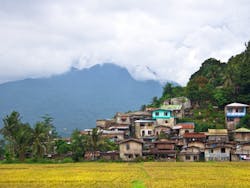The Philippines microgrid market appears poised to surge as new rural electrification regulations and programs open doors to project development.
Working to realize President Rodrigo Duterte’s goal of 100 percent electrification by 2022, the government is implementing regulatory changes and new programs related to microgrid projects, according to Afnan Hannan, CEO and co-founder of Okra Solar. The company develops off-grid, village microgrids with three local partners in the Phillipines.
The Philippines Energy Regulatory Commission (ERC) is amending draft rules that should clarify development of microgrid projects by private companies in areas where electric cooperatives hold franchise rights, Hannan said.
As franchise holders, co-ops have long been the main agents of rural electrification in the Philippines. But they have not been able to reach all customers.
“…it’s not economically viable for the co-op to extend the grid out to them.” — Hannan
“We spoke with electric cooperatives and they told us that roughly 50 percent of the 2.4 million off-grid households are in ‘unviable’ areas, which means that it’s not economically viable for the co-op to extend the grid out to them,” Hannan told Microgrid Knowledge.
That’s changing fast as the Duterte administration embraces alternative, distributed and renewable energy technology as a means of electrifying remote communities.
Solar-storage microgrids are emerging as a leading option due to the speed at which they can be deployed and scaled, as well as their reliability, efficiency and falling cost, Hannan said. He sees the new rules creating a greater degree of investment certainty for developers, while the new rural electrification programs open up opportunities — and better project economics — in the Philippines microgrid market.
New category of independent power producers
A new category of private, independent power producers known as qualified third parties (QTPs) offer an example of the regulatory and market changes speeding off-grid electrification in the Philippines, he said. To qualify as a QTP, developers must apply to government authorities for licenses that permit them to build, own and operate microgrids in the cooperative service territories.
The electricity generated by independent power producers may be sold at unsubsidized or subsidized rates depending on the IPPs qualifications. Those that qualify as QTPs receive compensatation for any difference should their power generation and distribution costs be higher than the subsidized rates customers pay for electricity, Hannan said.
Economics of microgrids and rural electrification
Digital, remotely controlled and managed solar-storage and microgrid-as-a-service systems, such as those offered by Okra and partners, open up new avenues for rural electrification, Hannan said.
The Philippines recently launched a PV Mainstreaming Program that offers an example. Customers pay a daily, as opposed to per-kWh, rate of 8 Philippine pesos, roughly US$0.15, per day for a system designed to provide a minimum 88 watt-hours per day.
PV Mainstreaming Program energy providers are able to offer larger capacity systems at higher rates without having to obtain ERC approval. Okra aims to take advantage of that by offering higher service tiers to customers who consume more than the average amount of energy.
“We think they’ll say yes. They’ll get double the energy for the same amount and then we’ll look to provide higher tiers of energy access at slightly higher rates, say 350 watt-hours per day for households that want to run fans and TVs, or even small refrigerators…Those are what’s going to pay off the investment,” Hannan said.
In addition to households with higher loads, so-called ‘sari-sari’– village convenience store and other small business owners – may decide to invest more in their businesses, or start new ones, given affordable, reliable energy access.
“They might need a refrigerator or freezer to extend the shelf life of fish, meat or produce, for example…Their products would have a longer shelf life and the quality would be better, which could lead to higher revenues. We want to provide an energy-as-a-service and focus our marketing efforts on explaining how our service can help households and sari-saris make productive use of energy and improve their livelihoods,” Hannan said.
Track news about the Philippines microgrid market. Subscribe to the free Microgrid Knowledge newsletter.







